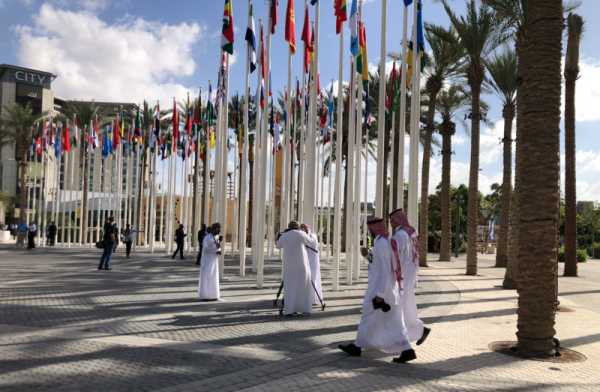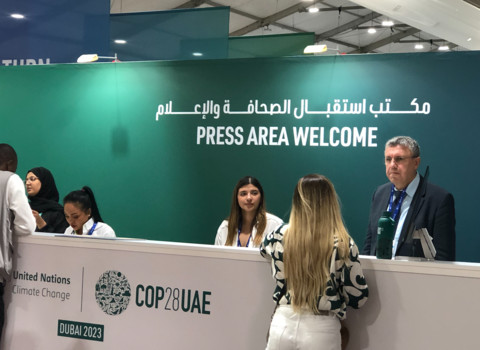
One thing that has changed significantly about COP is the scale — in Poland in 2008 fewer than 10,000 people attended (Photo: Pascale Palmer)
The big end-of-year COP28 climate summit is a strange beast — thousands of similar-minded delegates in one space, rushing from meeting, to panel discussion, to negotiation, to press conference, gut-bacteria synced to the limited food offerings. (There are memorably bad stories from last year’s COP in Egypt, when the toilet tanks exploded and the negotiators ran out of food and water.)
Right now, as COP28 gets underway, Dubai feels like an interesting kettle of fish.
-

The warning to journalists to ‘refrain from publishing anything that could offend directly or indirectly the ruling regime of the state’ or that ‘could be offensive to the national unity and social cohesion’ was quickly retracted (Photo: Pascale Palmer)
The desert city plays regular host to major events but coming in from the airport, you wouldn’t know more than 160 heads of state and government, plus an estimated 100,000 participants are either here already, or about to descend.
Discussion of the biggest existential threat humanity has ever faced is barely mentioned on billboards or signage, yet visitors are made aware quite quickly that the world rugby sevens tournament is imminent.
On the ground in the sprawling flower-shaped convention centre, there’s a feeling of determined activity. From a logistical perspective, there’s still quite some work to do — with ladders, and hard hats, scaffolding and board walkways littering some of the further extents of the site.
But the silent determination from negotiators already on the ground may well stem from a desire to push aside the recent revelations that the COP president’s office may have used summit-related meetings to broker oil deals, and get out the other side with something like a credible set of decisions.
Talk over recent years has frequently turned to whether the UNFCCC process is fit for purpose; it is hard when year-after-year the incremental steps agreed fly full in the face of a torrent of climate related devastation. The harder-to-photograph long-term gamechangers, like reduced sea ice, permafrost thawing and decreased water resources in already-arid regions won’t wait for COP negotiators to get their act together.
It’s also difficult not to want to do something differently when those in the eye of the literal storm are generally being made to wait for money, tech, and acceptance of responsibility by those rich countries who have contributed most to the global climate crisis.
I met a man in a queue from the Small Island States delegation, and after the usual chitchat about how things were going for each of us, he asked me to do anything I could to help. “Anything at all.” And it’s that juxtaposition of world-shattering consequences and the quotidian dullness of a conference that makes COP so unnerving, so exhausting and also, probably the most pragmatic choice for discussions on this scale of complexity.
One thing that has changed significantly since my first COP in Poland in 2008 is the sheer scale: fewer than 10,000 people attended back then. Last year’s Africa COP hosted by Egypt was the biggest so far with nearly 50,000 participants and 3,700 registered media. Fifteen years ago in Poznan only 800 accredited journalists turned up.
The media centre in Dubai is spacious and well-laid out, with computer stations and cubby offices labelled for hundreds of outlets, there’s a café and breakout spaces and the outside broadcast position takes in a backdrop of palms, flags and sunshine.
Media tips — don’t criticise UAE
A clearer sense of what the UAE thinks of the press, however, was given when they sent round “media content standards” earlier this year, which called for journalists heading to Dubai to “refrain from publishing anything that could offend directly or indirectly the ruling regime of the state” or that “could be offensive to the national unity and social cohesion”.
That document was removed from the internet sharpish after media queries, with the explanation that it was an old guide and not relevant to COP28.
That said, there’s something exciting in the conditioned air in Dubai. On Day 1, agreement on the loss and damage fund was met with a standing ovation, with both UAE and Germany pledging $100m [€92m]. And some deft handling of the gathered parties managed to remove new items from the agenda, meaning everyone could just get on with the job. In the wings there is talk of a $30bn climate-related investment fund with some hefty players reportedly signed up.
All of these are big early wins for COP president Sultan Al Jaber and a small number of engaged voices are daring to play with the idea that this COP could be an ‘only Nixon can go to China’ moment, where it’s the fossil-fuel insider who can make bigger strides forward than we ever expected.
It’s a lovely idea, but maybe wise not to hold our breath.
Source: euobserver.com